CENTRAL BUREAU
IN AUSTRALIA DURING WWII
A Research and Control Centre for the Interception and cryptanalyzing of Japanese intelligence
![]()
Central Bureau was one of two Allied Sigint organisations in the South West Pacific area (SWPA). Central Bureau was attached to the HQ of the Allied Commander of the South West Pacific area. The other unit was the joint RAN/USN Fleet Radio Unit, Melbourne (FRUMEL), which was subordinate to the Commander of the USN 7th Fleet.
"Sigint" is a code name for Signal Intelligence. Sigint operations were so secret that they were given their own special classification of "Ultra Secret". The word "Ultra" was used as a code name for intelligence derived from interception and decoding of Japanese military and naval messages.
General Douglas MacArthur had his own signals intelligence unit, Station 6, while he was in the Philippines and was not fully dependent on the U.S. Navy for that type of information. However, most of the signal intelligence he received was from the Navy unit on Corregidor. Prior to the war, it had to be sent by water courier, which caused some delay.
General Douglas MacArthur escaped from Corregidor in the Philippines in a PT boat to Mindanao and flew to Australia from Del Monte on a B-17 Flying Fortress. He made his way to Melbourne, arriving there on 22 March 1942.
The Signals Intelligence units operating in Australia at the time of MacArthur's arrival in Melbourne were as follows:-
- No. 4 Australian Special Wireless Section at Park Orchards near Ringwood in Melbourne
- a small Diplomatic and Press intercept section at Park Orchards
- A Diplomatic cryptographic and intelligence section at Victoria Barracks, Melbourne
- Some British Army Signals personnel from the Far East Combined Bureau who had escaped from Java
- a small RAAF Intercept section in Darwin
- a small RAN intercept and Direction Finding (D/F) organisation
- a small RAN cryptographic and intelligence section at the Navy Office in Melbourne
- US Navy Sigint group who had escaped from Corregidor by submarine
One of his first decisions when he arrived in Melbourne was to expand the Sigint operations that already existed in Australia. The United States Navy crypto group that had been evacuated from Manila in early January 1942 was operating in Melbourne. They were responsible for channelling all Sigint information to US Navy headquarters in Washington. MacArthur was not happy to depend on the Navy's discretion to handle his Sigint requirements. He had experienced problems with such an arrangement when he was in Manila. MacArthur's Intelligence Officer (G-2) was Major General Charles A. Willoughby.
Brigadier-General S. B. Akin, MacArthur's Chief Signals Officer, held discussions with Major-General Colin Simpson. They agreed that a Research and Control Centre to handle Signals Intelligence (Sigint) needed to be established. MacArthur subsequently released orders for the formation of two complementary groups:-
1. An Intercept Organisation known initially as No. 5 Wireless Section
2. A Research and Control Centre known as Central Bureau.
Central Bureau was a joint American-Australian Sigint organisation which was established on 6 April 1942 under the command of Major General S. B. Akin with its headquarters based in Melbourne. General MacArthur advised Washington of his decision in a dispatch on 1 April 1942. He described the role of the group as "the interception and cryptanalyzing of Japanese intelligence". The name Central Bureau was chosen so as to convey no information whatever to outsiders as to the nature of the work being done.
With the establishment of Central Bureau on the 6 April 1942, Australian Army Intelligence staff were attached to individual Australian Army Signals Units in the field as well to the various sections within Central Bureau at their headquarters at "Cranleigh" in Domain Road, South Yarra in Melbourne. In early 1943 separate Special Intelligence Personnel Sections SIPS were formed by the Australian Army to regularise administration. Two of the SIPS were self contained intelligence cells, complete with traffic analysts, cryptographic personnel, linguists and drivers who would embed with the forward deployed Special Wireless Sections to provide immediate analysis and feedback to local Army commanders. They would also pass back raw intercepts of enemy transmissions to Central Bureau for analysis. Most of the Australian Army intelligence staff were attached to Central Bureau and only 3 and 4 Special Intelligence Personnel Sections were deployed to forward areas with Special Wireless Sections. In August 1944, the separate SIPS were absorbed into a new unit called 1 Australian Special Intelligence Personnel Group 1 ASIPG allowing a more flexible organisation. The detachments in the Northern Territory and New Guinea remained and later detachments joined Advanced Echelon Central Bureau at Hollandia in Dutch New Guinea and the Forward Echelon Central Bureau in the Philippines.
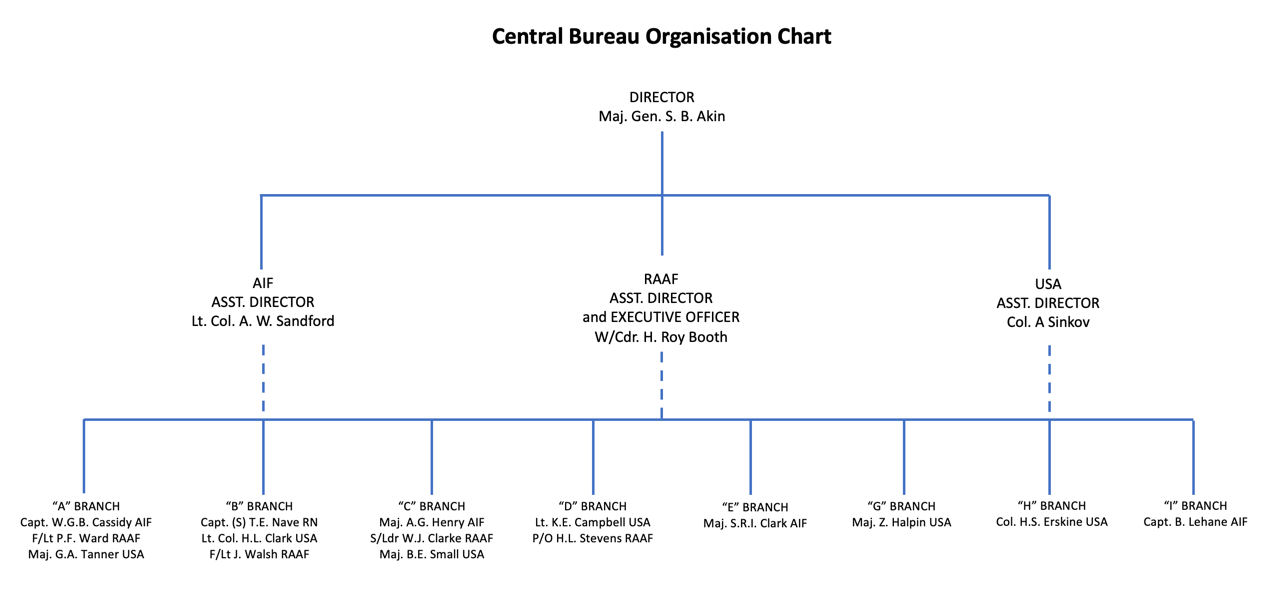
The following personnel were absorbed into Central Bureau:-
- The intelligence section of the former No.
4 Australian Special Wireless Section
- Australian Military personnel
- RAAF personnel
- US Army intelligence personnel who had escaped from the Philippines
- US Army intelligence personnel from USA (6 officers and 8 men of the 837 Signals
Service Detachment)
- British intelligence staff from Singapore
A small group from Australian naval intelligence, led by Paymaster Commander R.E. Eric Nave and Professor A.D. Dale Trendall, also became part of the secret new unit. They had been working on Japanese diplomatic codes.
Central Bureau was established in a gabled, ivy-clad mansion called "Cranleigh" in Domain Road, at South Yarra, Melbourne.
Central Bureau's role was to research and decode Army and Air intercept traffic and work in close co-operation with other Sigint centres in the USA, United Kingdom and India. Mic Sandford was appointed AIF Commanding Officer at Central Bureau.
12 enlisted men and four officers including Captain Harry L. Clark and Lieutenant Charles E. Girhard of the 837th Signal Service Detachment (In May 1943 became known as the SIS) arrived in Sydney from Hawaii and travelled down to Melbourne to work in "Cranleigh" under the direction of Captain A. W. Sandford. They were soon augmented by the arrival of more enlisted men. Shortly afterwards Major Abe Sinkov assumed command of the group.
Major Abraham "Abe" Sinkov, a mathematician, was appointed Assistant Director of Central Bureau. Sinkov had previously joined in the Signals Intelligence Service which had been founded by cryptanalyst William J. Friedman. Sinkov had previously been in charge of an intercept station in Panama. He had visited Britain in 1941 to facilitate the exchange of wireless information.
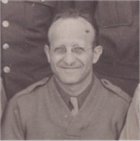
Major "Abe" Sinkov
The Military Phone books for Brisbane show the following entries for Abe Sinkov:-
| Phone Book | Name & Rank | Duties | Organization | Res. Phone | Office Phone |
| Dec 1942 | Sinkov, Major | C.O. 837th Sig. | Base Section 3 | M 1312 | AMP 98, 99 |
| Oct 1943 | Sinkov, A., Lt. Col. | ------- | USAFFE | M 1312 | AMP 98, 99 |
| May 1944 | Sinkov, A., Lt. Col. | ------- | USAFFE | M 1312 | AMP 98 |
| Feb 1945 | Sinkov, A., Col. | ------- | USAFFE | M 4796 | M 2101 |
While looking for Abe Sinkov's entries in the Military Telephone Directories for Brisbane, I noted that Abe's entries did not seem to appear in the main body of the various Telephone Directories but only in the Index at the back of the books. The other item of interest was that his duties were shown as a blank entry after the December 1942 edition. These Telephone Directories show entries for many secret intelligence etc units but it would appear that entries for a number of people in the index do not show their duties. So I decided to do a search for those whose Index entries do not show their duties. Having said all this it is interesting to note that there was a small entry in the main body of the Directories for Central Bureau as shown further down this page. There are literally thousands of entries in the May 1944 Military Telephone Directory for Brisbane but only the following entries show no entry in the Duties column.
MAY 1944 BRISBANE MILITARY TELEPHONE DIRECTORY
| Name & Rank | Duties | Organization | Res. Phone | Office Phone |
| Beall, J.R., Lt. | ------ | USAFFE | JLX 245, Ext. 844 | AMP 98 |
| Booth, R.H., S/Ldr. | ------ | RAAF | - | AMP 98 |
| Clark, H.L., Major | ------ | USAFFE | JLX 245, Ext 830 | AMP 98 |
| Clarke, W.J., F/Lt. | ------ | RAAF | AMP 638 | AMP 98 |
| Coombs, M.R., Lt. | ------ | USAFFE | JLX 245, Ext 841 | AMP 98 |
| Doud, H. Col. | ------ | USAFFE | B 2291 | AMP 98 |
| Erskine, H.S. Major | ------ | USAFFE | JLX 245 | AMP 98 |
| Estes, E.W., Lt. | ------ | USAFFE | AMP 778, Ext. 753 | AMP 98 |
| Fitzpatrick, J.E., Lt. | ------ | USAFFE | MLX 422 | AMP 98 |
| Fraser, J.B., Lt. | ------ | USAFFE | JLX 245 | AMP 98 |
| Goldie, G., P/O | ------ | RAAF | AMP 98 | |
| Linton, R.M. F/Lt. | ------ | RAAF | AMP 98 | |
| Mahrt, O.F. W/O | ------ | USAFFE | MLX 422 | AMP 98 |
| Sinkov, A., Lt. Col. | ------ | USAFFE | M1312 | AMP 98 |
| Wilson, A.M. F/O | ------ | RAAF | - | AMP 98 |
The above personnel were obviously all part of Central Bureau. A number of them can be seen in the photographs below.
The existing experienced RAAF intercept Kana operators at Townsville were integrated into the new Central Bureau. The RAAF at the time had a number of Kana operators being trained and were about to train a further 13 WAAAF personnel. "Kata Kana" was a form of Japanese written and spoken language.
Central Bureau comprised:-
- administrative personnel
- supply personnel
- cryptographic personnel
- cryptanalytic personnel
- interpreters
- translators
- a field section which included the intercept and communications personnel
It is thought that Major General Akin brought the American interceptors who had survived the Malinta Tunnel at Corregidor back to Australia by submarine. Another source indicated that they may have been evacuated by air transportation means. (Does anyone have conclusive proof of their means of escape?) They were used to assist the Australian Wireless Group units. A group of cryptographic, cryptanalytic and translator personnel from the Japanese section of the Washington Signal Intelligence Service were also moved to Australia. More Australians were also recruited to Central Bureau after its initial establishment.
Major General Akin's Executive Officer, Joe R. Sherr, had been evacuated from the Philippines and was responsible for arranging for the first group of US "Sigint" personnel to come to Australia.
Initially Central Bureau was made up of 50% American, 25% Australian Army and 25% RAAF personnel.
Technical Sergeant Don Moreland of the 837th Signals Service Detachment (later became SIS) slept on cots set up on the floor of Cloudland Ballroom which he knew as Luna Park. Don remembers that there was a cable car there which had carried visitors up the steep hill to the dance hall. It was not in operation when he was there. Don said that the ballroom floor was mounted on top of springs and tended to sway when people walked across it.
Don Moreland helped to establish and then operate the IBM tabulators for General Douglas MacArthur's top secret signals intelligence unit which was known as Central Bureau. The IBM tabulators were located in a large garage behind a large 2 storey house located at 21 Henry Street at Ascot.
On 25 April 1942 the small RAAF Intercept Station operating in two back-to-back houses at 21 Sycamore Street and 24 French Street in the suburb of Pimlico in Townsville was given its new name of No. 1 Wireless Unit and became part of Central Bureau. The newly named Unit comprised 7 RAAF, 1 AMF and 4 United States Army personnel (1 Officer & 3 Enlisted Men) in No. 1 Wireless Unit at Townsville. This RAAF Unit had started earlier in March 1942 as a small intercept station located in the initial two houses at Pimlico under Wing Commander Booth. The four Americans had previous experience in this work in the Philippines before they were evacuated.
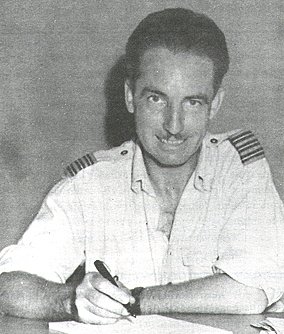
Wing Commander Booth RAAF
AMF Units were sent to Darwin and Port Moresby with the Darwin group operational by June 1942 and the Port Moresby group by September 1942. The establishment of these intercept units in Townsville, Darwin and Port Moresby saw a steady flow of intercept material to Central Bureau at 21 Henry Street, Ascot for analysis. The early work consisted of the recording of all frequencies being used by the Japanese, reconstructing the Japanese radio nets, locating the transmitting stations, and identifying their call signs and frequencies.
At this time the primary missions of Central Bureau related to field problems and low echelon material. Any facilities available after these functions were full discharged, whether intercept of analytic, could be applied to the high command problem.
Commander Nave moved to Central Bureau in mid-1942 from the combined Australian Navy/U.S. Navy operation in Melbourne known as FRUMEL, which was put under U.S. Navy control in mid-1942. Although he headed up the “Solutions” division there, most records indicate he only dealt with minor Japanese naval codes and simple substitution ciphers in spite of his Japanese language capability and long history with Japanese codes. Colonel Sinkov and his American staff worked on the high-level Japanese Army codes.
By 6 July 1942 the intercept operator numbers at Central Bureau had increased from six to twenty nine.
On 20 July 1942, General MacArthur moved his Headquarters to Brisbane. Central Bureau relocated to Brisbane in September 1942, establishing its headquarters in "Nyrambla", a huge house at 21 Henry Street, high on a hill in the suburb of Ascot, not far from the new American airfield at Eagle Farm. This move was necessary to ensure that Central Bureau was in close touch with GHQ SWPA and Allied Air Intelligence. It also reduced the time lag in the passage of raw material from the Field Units.
A newspaper article that Bill Bentson showed me stated that an Alan Jenkin worked for "Number One Unit" which was a cover name for Central Bureau at Ascot Park. More likely it was an alternative name for No. 1 Wireless Unit RAAF or possibly Hut 1 at Camp Ascot Park.
By the end of 1942 Central Bureau headquarters strength had grown to approximately 150 personnel. A small IBM section was functioning efficiently, traffic volumes was increasing, and methods were being developed for the proper handling of traffic.
The 126th Signal Radio Intelligence Company had been assigned to Central Bureau in late 1943. They had earlier been located in Townsville monitoring Allied Air Reconnaissance frequencies, and assisting No. 1 Wireless Unit to secure bearings on enemy aircraft using their Direction Finding Stations located at Townsville, Cairns, Charters Towers, and Cloncurry. Their work was not that successful and they relocated to Northgate in Brisbane in late November 1942. Detachments of the 126th SRIC were also in operation at Adelaide River in the Northern Territory and at several locations in New Guinea during 1943.
Central Bureau did not break any high level Japanese Army codes until mid-1943 with the Water Transport code. Later that year, one main line Japanese Army code was broken.
In January 1943, Central Bureau was placed under the direct control of GHQ SWPA by the issuance of Operations Instructions No. 27 of GHQ SWPA dated 20 January 1943 which provided (inter alia) as follows:-
a. An Allied Central Bureau for the conduct of cryptographic operations and the supervision, co-ordination and operational control of the incidental Signal Intelligence activities of the Allied Land and Air Forces and the United States Army Services of Supply, was established effective January 27th, 1943.
b. The Central Bureau functioned under the direct control of General Headquarters, Southwest Pacific Area.
c. The mission of the Central Bureau was defined in the following terms:-
(1) Cryptographic.
(a) The cryptanalysing of the cryptographic systems employed for the secure transmission of enemy military traffic over point-to-point, air-ground and air-surface craft circuits.
(b) The translation, preparation and dissemination of traffic, the cryptographic system for which has been solved.
(c) Making available to superior and/or subordinate agencies, when directed by proper authority, the keys to solved systems.
(d) The compilation of the codes and cyphers required for common use by the components of the S.W.P.A.
(2) Radiogoniometric and Identification.
(a) The reception, collation, evaluation and analysis of such intercepted military radio point-to-point, air ground and air-surface craft traffic as may be necessary to provide for military intelligence purposes.(b) The identification and location of enemy aircraft, surface craft (carriers and tenders only) and military shore stations used for military point-to-point and ground-air and/or land-aircraft carrier purposes.
(c) The location and identification of enemy headquarters and other important enemy activities and establishments.
(d) The movements and location of enemy aircraft, particularly those that may become engaged in raids against friendly areas or forces.
(e) Data with regard to meteorological conditions in friendly and enemy territory.
(f) Distribution of the above data to the agencies designated by General Headquarters S.W.P.A. to receive the same.
(3) The Planning For and Co-ordination of Intercept Activities
(a) Planning for the required intercept and direction finding personnel, equipment and stations.
(b) Allocation of personnel, equipment and station facility requirements to the Allied Forces for the production of the properly trained and equipped personnel and required fixed intercept and direction finding stations and facilities.
(c) Assignment and co-ordination of the missions of the various detachments engaged in direction finding and intercept work.

"Nyrambla" 21 Henry
Street in its early days
Note the verandahs are not enclosed
Photo taken from Yabba St side
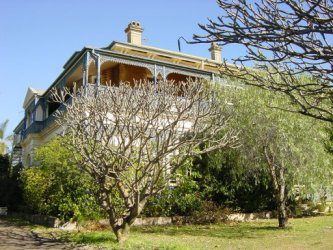
"Nyrambla" 21 Henry
Street, Ascot
Photo taken from the Henry St. side
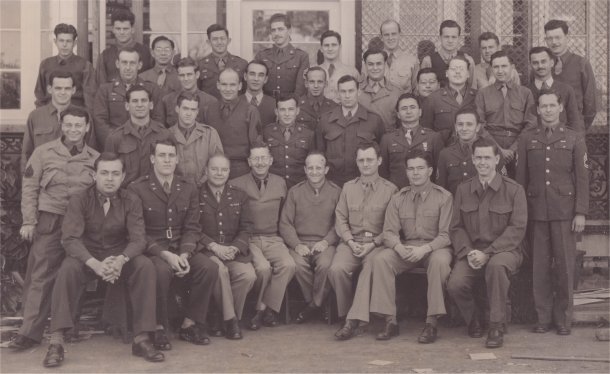
| Colonel Sinkov and his American
staff in about July or August 1943 at the rear of Central Bureau HQ at 21
Henry Street, Ascot. Most of the officers and men of the U.S. Signal
Intelligence unit, the U.S. component of MacArthur's Central Bureau, are
in the photo. A few men, mostly from the night shift of the IBM
unit, did not get in this photograph.
Front Row: Maj. C.E.Sirhard?, Capt. C.W. Ray, Capt. Hoffman, Maj. H.S. Erskine, Col. A. Sinkov, Lt. Col. H.L. Clark, Capt. Z. Halpin, C.W.O J.E. Richard. 2nd Row: W.O. M.J. Cohen, M/Sgt. M.M. Wishnack, M/Sgt. C. Young, M/Sgt. J. Dallas, Sgt. C.E. Newitt, Lt. J. Fitzpatrick, S/Sgt. P. Sebestian, W.O. J. Jonakoplos?, M/Sgt. W. Estip. 3rd Row: T/Sgt. E. Brown, Cpl. C. Tigges?, Lt. D.A. Swanson, Lt. O. Mahrt, T3 J.G. Tracy, T/Sgt. H.D. Ephron, T3 M.S. Cohen, T/S Tipman, T/Sgt. A.W. Shirley, W.O. L.W. Toepperwin? 4th Row: T3 E.D. Dillon?, T3 O.W. Vann?, Capt. C.S. Yamagata, T3 J.W. Allen, Lt. L.S. Truex, M/Sgt. C.D. Hemler, T/3 M.G. Benedict, Lt. G.K. Bailey, T/Sgt. B.E. Snider, T/Sgt. F.J. Bright |
Click on the thumbnail for a much
larger version of the above photo
The October 1943 and May 1944 Brisbane Military Telephone Directories show the following entries for Central Bureau at Ascot. It was shown as being part of RAAF Command:-
| OCTOBER 1943 | MAY 1944 |
| S/Ldr. Booth, H.R. F/Lt. Hattam, E.C. F/Lt. Clarke, W.J. F/O Clements, R.A. F/O Gibson, G. F/O Newall, H.W.P. P/O Guiver, G.A. Flt. Off. Crisp, H.M. |
S/Ldr. Booth, H.R. F/Lt. Burbidge, B.W. F/Lt. Linton, R.M. F/Lt. Clarke, W.J. F/Lt. Clements, R.A. F/Lt. Walsh, J.D. F/Lt Newall, H.W.P. Flt./Off. Crisp, H.M. F/O Davis. A.I. F/O Barnard, R.A. F/O Wilson, A.M. P/O Goldie, G. Clerks |
For the first year and a half of the war, MacArthur was almost totally dependent on the U.S. Navy for signals intelligence. Even after the Army and Central Bureau started breaking Japanese Army codes in 1943, the U.S. Navy, including FRUMEL, still provided a reasonable share of the intelligence his staff needed.
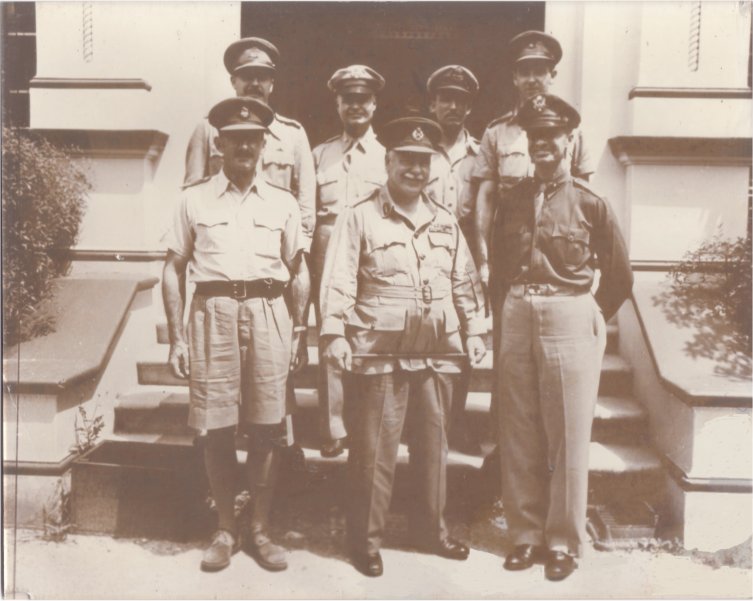
|
General Blamey inspecting his and General Douglas MacArthur's Central Bureau - Signal Intelligence Service at 21 Henry Street, Ascot on 25 February 1944. Front Row L - R:- Australian Brigadier John Rogers; General Sir Thomas Blamey; U.S. Major General Spencer B. Akin, MacArthur's Signal Corps Commander and Director of Central Bureau. Rear Row L - R:- Australian Aide-de-camp for Gen. Blamey, Major R.E. Porter; U.S. Colonel Harold S. Doud, Commanding Officer of the U.S. Signal Intelligence Service component of Central Bureau and Deputy Director of Central Bureau; Australian Wing Commander Henry Roy Booth, RAAF Deputy Director throughout WW2 of the Australian component of Central Bureau; Australian Lieutenant Colonel Alistair W. Sandford, AIF Deputy Director throughout WW2 of the Australian Army component of Central Bureau |
In the last quarter of 1943, Colonel Doud became Commander of the Allied Geographic Service for MacArthur. Colonel Abraham (Abe) Sinkov then became Commander of the U.S. Signal Intelligence Service at Central Bureau.
Another separate Intelligence operation was located in the same general area in a building called "Palma Rosa" at 9 Queens Road, Hamilton. "Palma Rosa" was commandeered by the Counter Intelligence Corps, G-2 Section, Headquarters U.S. Army Forces in the Far East (U.S.A.F.F.E.).
 No. 1 Wireless Unit personnel who were trained at 21 Henry Street, Ascot |
A close-up of the photo on the left More Photos of No. 1 Wireless Unit personnel in training at 21 Henry Street, Ascot can be seen at the No. 1 Wireless Unit Home Page |

Photo:- Harold Bolitho via Neil Bolitho
Course 4, at Camp Ascot Park on 24 June 1944, Brisbane, R.A.A.F Command, Central Bureau
|
Back Row:- LAC Earl Ross (NSW), Bob Fischer (Sale, Vic), Harold Bolitho (Sale, Vic), Thalhammer (?) (USA), O’Shannasy (USA), ??? (USA), Fl Lt Burbage, Fl Lt Linton (Mildura), Lt Col Sandford, Sq Ldr Booth, Lieut Atcheson (USA), Lieutenant Toothacher (USA), ??? (USA) Oscar (USA), ??? (USA), LAC Noel Langby (NSW), Jim Nodwell (QLD), Kerry Bright Middle Row:- LAC Noel Proctor (NSW), Bill Carter (Vic), Ern "Nate" Routby (USA), Bob Norris (USA), ??? (USA), Stevens (USA), ??? (USA), ??? (USA), Moses (USA), Arnecon (?) (USA), ?? (USA), Schmitt (USA), Gorring, Fl Sgt Bennett, LAC Witham (Vic) Front Row:- LAC Fred Bryant (Vic), Sgt Bert Gough (Vic), LAC Stuart Muntz (Vic), Noel Clarke (Vic), Harry Clarricootes (?) (Vic), Reg Murphy (NSW), Alan Mierisch (?) (Vic), Nightingale (Vic), Lo…(?) Burgess (QLD) Absent:- Alan Pharoah (Vic) |
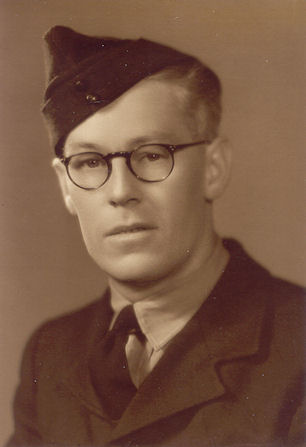
Harold William Bolitho (144008), a
member of Course 4,
in June 1944, at Central
Bureau in Brisbane
General MacArthur established his Headquarters in the AMP Building in the city area only a few buildings from the Brisbane General Post Office.
Central Bureau had banks of IBM Tabulators, the forerunner of computers, which were used by the cryptanalysts to sort and strip away ciphers which concealed the original text. They were located in the garage at the rear of 21 Henry Street.
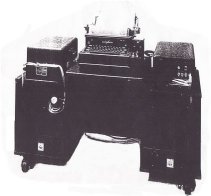
This may have been the IBM
Tape Operated Equipment used
at 21 Henry Street
and then at the
Fire Station at Ascot Park
The IBM machines were later moved from the garage at 21 Henry Street to the Fire Station at Ascot Park. After the IBM machines were removed from 21 Henry Street the garage was occupied by No. 11 Australian Cypher Section. The garage was filled with Typex machines which were operated by some Australian Women's Army Service (AWAS) personnel.
Beginning in January 1942, U.S. Navy stations in Hawaii (Hypo), Corregidor (Cast) and OP-20-G (Washington) began issuing formal intelligence decrypts far in advance of the U.S. Army or Central Bureau. FRUMEL in Australia obtained IBM equipment in 1942 to replace that which was left behind on Corregidor and employed it throughout their tenure there in Melbourne.
Central Bureau moved to a new location at 45 Eldernell Terrace, Hamilton on an unknown date.
Central Bureau also had access to the following intelligence organisations facilities:-
- the Geographical Section which produced maps and geographical data about the SWPA
- the Allied Translator and Interpreter Section (ATIS) which interpreted millions of captured documents, intercepted messages and interrogated thousands of Japanese POWs
- the Australian Coast Watching Service
Japanese POW's were interrogated at a house called "Tighnabruaich" at Indooroopilly in Brisbane.
Central Bureau at 21 Henry Street, Ascot in Brisbane decrypted a Japanese Army Air/Ground signal intercepted by 51 Wireless Section in Darwin that contained Admiral Isoroku Yamamoto's itinerary for his trip to Rabaul. Admiral Yamamoto was the Commander in Chief of the Combined Japanese Fleet, the architect of the attack on Pearl Harbor. Central Bureau reportedly sent the decrypted message to FRUMEL where it was reportedly translated by a U.S. Navy linguist.
Although Central Bureau may have decrypted this message, the interception of his flight was based on decrypts of Japanese naval messages by FRUPAC in Hawaii, FRUMEL, OP-20-G in Washington and Station AL on Guadalcanal. Major Lasswell USMC in Hawaii decrypted the Japanese Naval message first and Captain Layton gave it to Admiral Nimitz who authorized the shootdown attempt after determining from ComNavAirSoPac that it could be done with by one of his Army Air Corp units on Guadalcanal.
On 18 April 1943, based on information gleaned from these intercepts, Admiral Yamamoto was killed on his way to Rabaul when his aircraft was shot down by a flight of seventeen P-38 Lightnings of the 347th Fighter Group that were dispatched from Henderson Field, Guadalcanal. The P-38s were fitted with extra fuel belly tanks to make this long-range intercept.
The P-38s spotted Yamamoto's' aircraft, plus another bomber and their Zero escorts just west of Ballale on the southern end of Bougainville. Yamamoto's aircraft was shot down in flames. It crashed into the jungle and the other bomber containing Admiral Ugaki, the Chief of Staff Combined Fleet crashed into the sea. Yamamoto was killed but Ugaki survived his crash into the sea.
Most of MacArthur's General Headquarters staff moved from Brisbane to Hollandia in August 1944. MacArthur stayed back in Brisbane for a few weeks and then moved to Hollandia.
In late August 1944, the Australian Government requested that Canada's No. 1 Special Wireless Group be dispatched to Australia. The Unit arrived in Brisbane on 15 February 1945. They were assigned to Central Bureau in Brisbane.
No. 1 Special Wireless Group left Brisbane by train on 4 April 1945 headed for Darwin. They arrived in Mount Isa where they departed for Darwin via motor transport. They finally arrived in Darwin on 18 April 1945. While in Darwin No. 1 Special Wireless Group intercepted an average of 1200 Japanese messages a day.
In late 1944, as Central Bureau continued to grow it was divided into the following Branches.
Branch A - Administration
Branch B - Solution
Branch C - Communications
Branch D - Photographic
Branch E - Traffic Analysis
Branch G - Machine Procedure
Branch H - Translation
Branch I - General Intelligence and Liaison
By the end of the war, Central Bureau had grown to 4,330 personnel.
Judy Carson joined the AWAS in 1943 and was sent to 21 Henry Street. She worked with Professor Room in Hut 9 at Ascot Parkdeciphering Japanese weather codes. She lived at home while she worked there.
NOTE:- Defence Signals Directorate (DSD) was constituted as Australia's national Sigint authority in 1947 (or, more accurately, the Directorate's precursor organisation, the Defence Signals Bureau, later renamed the Defence Signals Division, was so constituted). As such, DSD became the releasing authority for Sigint-related records dating from the WWII period.
Central
Bureau reunion at 21 Henry Street on 1 May 1988
Organised by Central Bureau
Intelligence Corps Association
Signal Intelligence Units in Australia during WW2
Australian Signals Directorate
This link to another Internet site contains
information on WWII Sigint units
I am interested in hearing
from any ex members of
Central Bureau who may be able to assist me with
more information for this new home page on CBI
I am also interested in the history of 21 Henry Street
Central Bureau Intelligence Corps Association Newsletters
ACKNOWLEDGEMENTS
I'd like to thank Philip H. Jacobsen, Lieutenant Commander, U.S. Navy (ret.) for his assistance with this home page. Philip is a researcher and writer for the Cryptolog and other cryptologic publications.
I'd like to thank Pic Berthier, Neil Bolitho and John Feltham for their assistance with this web page.
REFERENCE BOOKS
Ballard, Geoffrey, "On Ultra Active Service - The Story of Australia's Signals Intelligence Operations during World War II", 1991
Bleakley, Jack, "The Eavesdroppers - The best kept secret of World War 2"
Maneski, Sharon A., "The Quiet Heroes of the Southwest Pacific Theater: An Oral History of the Men and Women of CBB and FRUMEL", 1996
Drea, Edward J., "MacArthur’s Ultra”
Spector, Ronald H., “The Eagle and the Sun”
Holmes, W.J., "Double Edged Secrets"
Prados, John, "Combined Fleet Decoded"
Layton, "And I Was There"
Can anyone help me with more information?
"Australia @ War" WWII Research Products
|
© Peter Dunn 2015 |
Please
e-mail me |
This page first produced 9 Apr 2000
This page last updated 11 September 2022